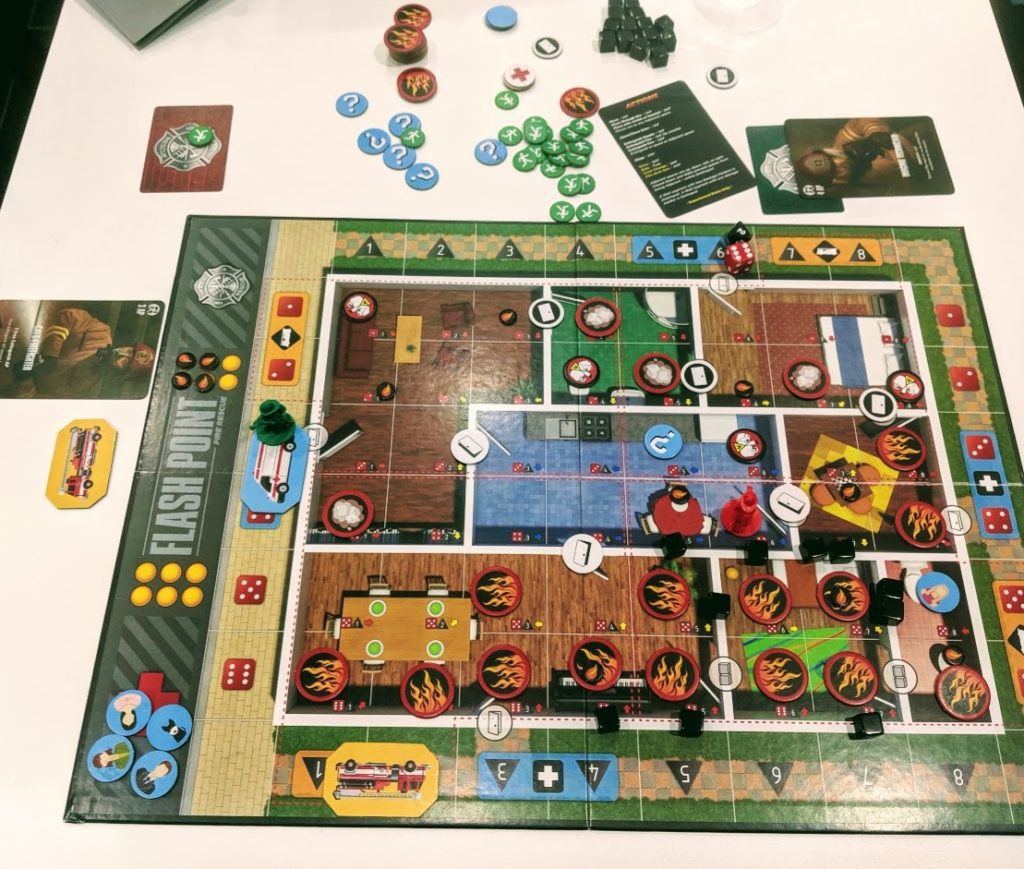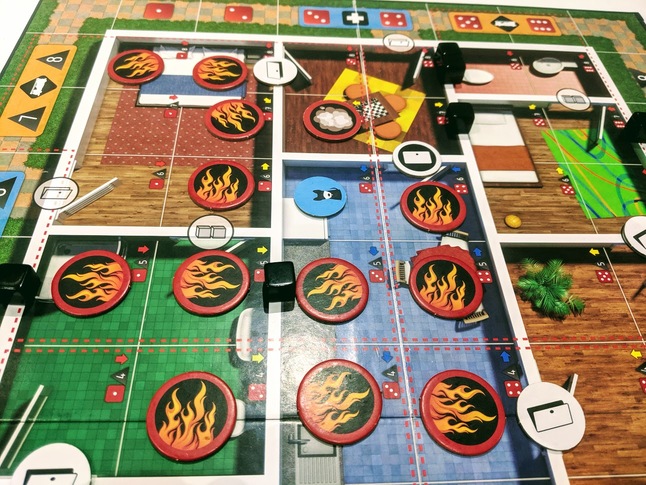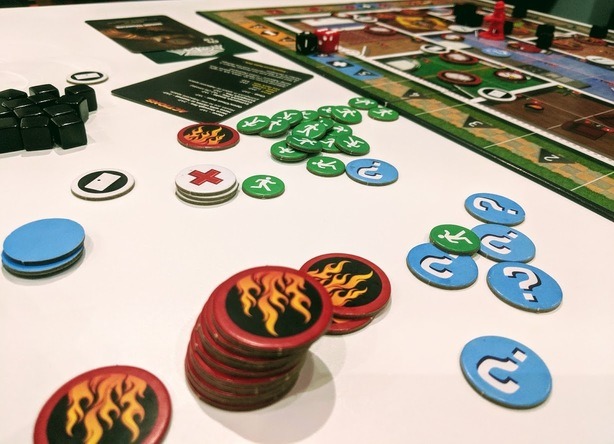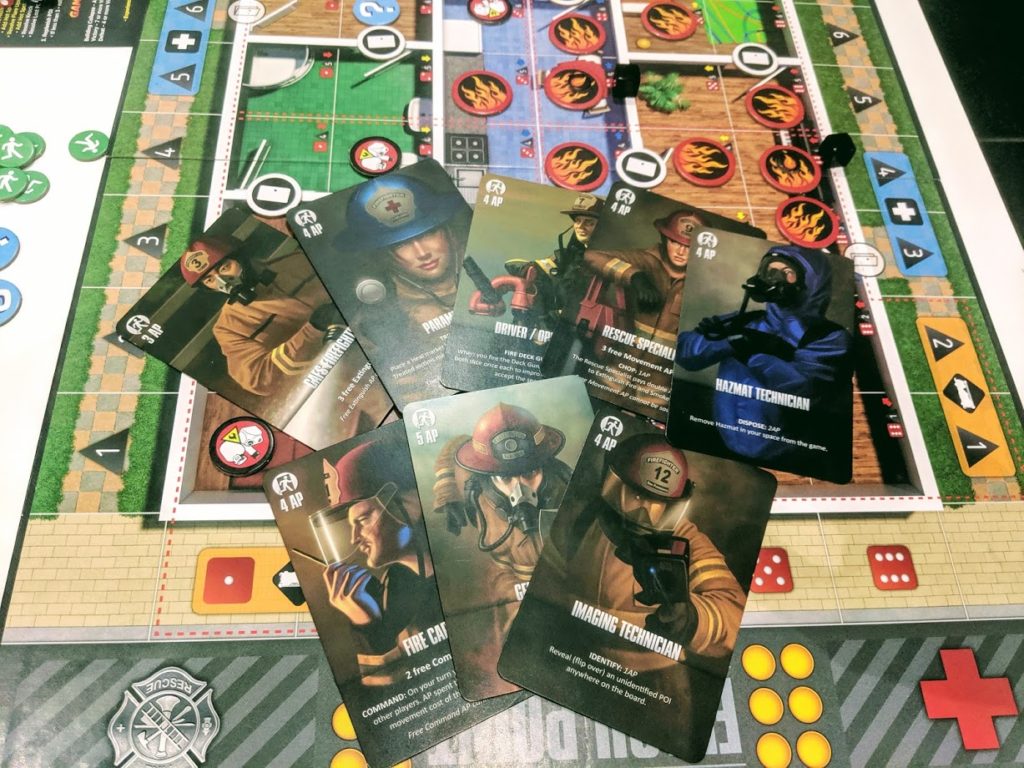“I’m going to move, then put out fire here, then move again. Roll the dice, 4-3, put down smoke there.”
“I’m going to put out fire here, then move, and then put out smoke here. Roll the dice, 4-4, smoke there, becomes fire, so does this.”
“I’m going to move, move, and then put out smoke here and move again. Roll the dice, 2-7, explosion, so damage here and here, fire here and here.”
“OK, maybe we should rescue some victims soon? The building is collapsing.”
“We are called firefighters, not potentialfirevictimrescuers. So I think we are fine.”
In Flash Point: Fire Rescue, players take on the hose of firefighters, and the goal of the game is to rescue a certain number of victims from a burning house before they succumb to the flames. Or, as the game gently puts it, before they become “lost”.
Following the good old co-op game blueprint to the very letter, every player’s turn consists of two phases. First, they have four actions that can be spent on moving, putting out flames, opening and closing doors, carrying victims, or chopping down walls so a dramatic entrance can be made. Then, once your actions are done, you roll the dice to see where the fire will spread, and new victims might also pop up randomly over the board. (Where they come from exactly in an area that you have already cleared is anyone’s guess.)

The game can be played with simple or advanced rules. In the advanced version, you also get two vehicles, an ambulance and a firetruck, hazardous materials around the house that can explode, and additional fire spreading rules. And you can choose from a roster of specialist firefighters which give you extra powers, for example, you can check victims from afar, put out fires more easily, or simply get an extra action point each turn.
The most intricate mechanism in the game is the fire spreading. Let me try to give you a taste of how it works. Fire has two levels, smoke and fire. Smoke does not hurt you per se, but it has a tendency to become fire: if at any point a smoke token is adjacent to a fire token, it becomes fire. Being in the same place as a fire token immediately kills the victims – sorry, makes them lost – and knocks out the firefighters. Every turn, a new level of fire is added to a random place on the grid. If there was nothing there, you put down a smoke token, if it was smoking, it is now on fire. Things get more complex if there was already a fire there. In that case, there is an explosion, fire spreads in all four directions, you put down fire tokens, or if there is no space, destroy doors / walls. In the advanced game, there are also hazmats, which also explode, and hot spots, which cause an additional level of fire spreading to a random place, and also makes that random place a hot spot.
The Good
Hm. Well, the theme is unique, it is easy to relate to, and there are occasional heroic moments in the game. For example, there is a victim trapped in the bathroom, flames are approaching, and there is a hazmat just over the wall, so you cut through the flames, axe the wall to stand aside, and run out with the victim in your arms just as everything is exploding behind you. There are also the occasional tough decisions to make, so the game has some strengths story-wise. It’s similar to Freedom: The Underground Railroad in that aspect, namely the strong story angle leads to technically suboptimal steps. This will be reflected in the relatively high story score (mediocre) the game gets from us. Spoiler alert.

We also found some of the mechanics interesting. Both the firefighters and the fire can damage the walls (the former because it wants to create a shortcut, the latter because fire’s gotta fire), but if the house becomes too damaged, 24 damaged to be precise, it collapses, and everyone inside dies. Sorry, I mean gets lost.
What else… We also liked how you can save action points from one turn to the next.
The Bad
Oh, God of Games, this game is so bland and boring and straight and humorless. If someone asked you to design a board game about rescuing people from a burning house, I’m fairly confident the game you came up with would match Flash Point by at least 70%.
Let me sidetrack the review a bit, and share a personal story of ours. Back in the undocumented dark ages of the early 2010s, at some point, we played a co-op board game. We did not like it at all, it was clunky, unsatisfying, and forgettable – in fact so forgettable that we can’t remember the name… The only thing we do remember is that there was a fire spreading mechanism. And the reason why we do remember that is because according to the rule book there were like 10 different points in any round where we had to check for fire spreading and apply it as necessary. Do an action, check if fire spreads, roll the dice, check if fire spreads, play a card, check if fire spreads. The fire spreading rule was complex too. So we came in prepared to face all the fire in the world. (In case you are not really paying attention, this is still that older game, not Flash Point.) And we played a game, and we did not encounter fire at all. It just didn’t appear. No fire whatsoever. Not a spark to spread. Since then, fire spreading became a very emotional inside joke for us, the epitome of bad and boring game design.
And rightfully so, based on our Flash Point experience. Fire spreading is really administrative-heavy and time-consuming, it’s actually the largest chunk of the game. Rolling the dice, checking those stupid fire tokens, administering the explosions, spreading the hot spots in the advanced mode, putting on damage tokens, this is what takes up most of the playtime.

Once you are done with the random threat-increasing, your turn is usually incredibly simple. There is no clever planning ahead, no insane strategies that might just work against all odds, no. You either move one space now, and put out the fire ahead of you, or put out a fire next to you, and move afterward. The threat is completely random, so there’s not much point planning ahead, and the general direction is extremely clear-cut – you need to get to the nearest victim. You literally spend every turn in putting-out-fires mode.
We also had our fair share of complimentary annoying factors, frankly, they were really tiny compared to the large, glaring issues, but here they are. The fire truck is stupid, it’s not worth it, and hazmat is a failed attempt to give more depth to the game. They are supposed to work in a certain way, but mathematically it is just not worth using them that way.
Oh, and the game is too easy.

Regarding aesthetics, it’s not an outright ugly game, but the artwork is all over the place. Firefighters are drawn in a realistic way, the house is comic-book style, and the victims are minimalistic icons. The purpose of that last bit is obviously to disconnect you from the fact that they are people burning alive, but if the artwork can make you ignore that, you are a psychopath. One other thing we really disliked was how difficult it was to identify the random place you rolled on the grid of the house. The house you play in is an 8 by 6 grid, and every random event is controlled by two dice, a d6 and a d8. But for some reason, even with the corresponding dice printed on every single place, so that is 8*6*2 = 96 dice icon on the map, even with that, we always had difficulty to find the corresponding tile. I can’t really describe why it was difficult, it sounds incredibly straightforward, I know, and yet it is not. I suspect it’s something about the graphic design.
Earlier I praised the game somewhat for its theme, but even that has glaring weaknesses. Once you start thinking about it, there are serious contradictions between theme and gameplay: that is not how fire spreads, that is not how victims randomly appear, that is not how structural damage works, that is not how victims stand hopelessly one inch away from an open door, etc.
The Co-Op
Co-op is not particularly good either, there is minimal interaction between the players, and since your turns are straightforward, there is no need to discuss what to do. I don’t think we had a single one of those “what are your plans for the next turn, hm, I see, in that case, maybe I should do this, what do you think?” moments. Whether you move and put out fire or the other way around has no impact whatsoever on the player doing similar chores on the other side of the board.

Personally, I also didn’t like how the firefighters are not really in danger, which means there is no opportunity to heroically save each other. If you accidentally step on a fire, you just respawn at the ambulance.
The Recommendation
Nope, we recommend that you play Pandemic instead. That game is simpler to play, has fewer rules but a much deeper strategy. There is literally no aspect of Flash Point where Pandemic does not win. All right, if you insist on a firefighting theme, Flash Point is still the best I have ever played, but that’s a very low bar, considering it’s also the only one. Which technically also makes it the worst firefighting game I have ever played. So there you have it.
Info
| Release Year | 2011 |
| Genre | Strategy |
| Difficulty | Easy |
| Number of Players | 1 to 6 |
| Length | 45 minutes |
Rating
| Overall | Bad |
| Story | Mediocre |
| Co-Operation | Bad |